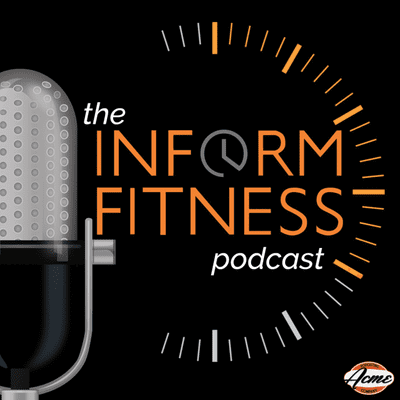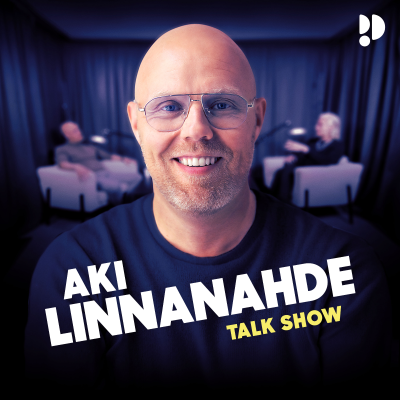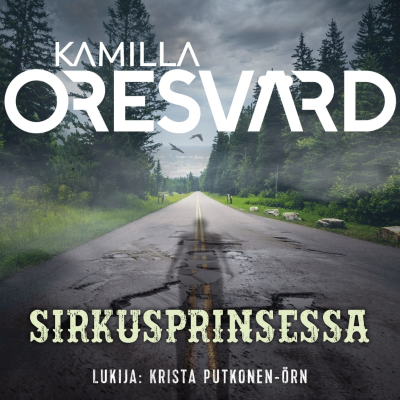
The InForm Fitness Podcast
Podcast by Inform Fitness / Acme Podcasting Company
Now listened to in over 70 countries, The InForm Fitness Podcast with Adam Zickerman is a presentation of InForm Fitness Studios, specializing in safe, efficient, High Intensity strength training. Adam discusses the latest findings in the areas of exercise, nutrition and recovery with leading experts and scientists. We aim to debunk the popular misconceptions and urban myths that are so prevalent in the fields of health and fitness and to replace those sacred cows with scientific-based, up-to-the-minute information on a variety of subjects. The topics covered include exercise protocols and techniques, nutrition, sleep, recovery, the role of genetics in the response to exercise, and much more.
90 vrk ilmainen kokeilu
Kokeilun jälkeen 7,99 € / kuukausi.Peru milloin tahansa.
Kaikki jaksot
77 jaksotWelcome to the InForm Fitness Podcast series REWIND, a listen back to the classic interviews we’ve had with the high intensity gurus & master trainers… names like Martin Gibala, Bill DeSimone, Simon Shawcross, Jay Vincent, Ryan Hall & Doug McGuff. This is the 3rd of 3 parts with veteran competitive bodybuilder, “biomechanics” expert, author and public speaker Doug Brignole. On his website Doug describes himself as “Bodybuilder on the outside & science nerd on the inside.” In part 3, Doug & Adam talk about Balance & Core training, intensity, reciprocal innervation. Enjoy! For more info about Doug Brignole: www.dougbrignole.com/ [http://www.dougbrignole.com/] www.greatestphysiques.com/doug-brignole/ [http://www.greatestphysiques.com/doug-brignole/] For Doug Brignole’s books, visit Amazon: www.amazon.com/Books-Doug-Brignole/s?rh=n%3A283155%2Cp_27%3ADoug+Brignole [http://www.amazon.com/Books-Doug-Brignole/s?rh=n%3A283155%2Cp_27%3ADoug+Brignole] As always, your feedback and suggestions are always welcome. Adam Zickerman – Power of 10: The Once-A-Week Slow Motion Fitness Revolution: http://bit.ly/ThePowerofTen [http://bit.ly/ThePowerofTen] We would love to hear from you with your questions, comments & show ideas… Our email address is podcast@informfitness.com [podcast@informfitness.com] 77: REWIND / Doug Brignole Part 3 Transcript Arlene 0:01 The Inform fitness podcast with Adam Zickerman is a presentation of inform fitness studios specializing in safe, efficient, personal high intensity strength training, in each episode Adam discusses the latest findings in the areas of exercise nutrition and recovery, the three pillars of his New York Times best selling book, The Power of 10. He aims to debunk the popular misconceptions and urban myths that are so prevalent in the fields of health and fitness. And with the opinions of leading experts and scientists, you'll hear scientific based up to the minute information on a variety of subjects. We cover the exercise protocols and techniques of Adoms 20 minute once a week workout, as well as sleep recovery, nutrition, the role of genetics in the response to exercise, and much more. Adam 0:56 Greetings, Adam here. Welcome back to the inform fitness podcast rewind. It's our listen back to classic interviews with some of the best high intensity gurus, master trainers, researchers and doctors in the business. This is part three with Doug Brignole, on his website, Doug aptly describes himself as a bodybuilder on the outside, and a science nerd on the inside. In this episode, we discuss balance and core training intensity and something called reciprocal intervention. Enjoy. You know, we started this whole talk, you know, talking about myths and belief systems. And here, here's another topic where that's fraught with a lot of different belief systems. So I think you'd agree that many physical therapists and trainers misuse the word balance when they refer to doing specific type of exercises that improve balance, aren't they really referring to improving proprioception rather than balance? And isn't proprioception and balance two different things? Doug Brignole 1:53 Yes, absolutely balances equilibrium. Balance has an inner ear. Also, the bottoms of your feet, and your eyes are the sensors that basically inform you, whether you're standing upright, or leaning to the right are about to fall, whether the ground you're standing on is flat or not the that is actually balanced. And as people get older, their senses start to deteriorate their eyes, they're there, they have neuropathy, so they don't feel their feet as much, right. So when someone says, you know, I lose my balance, well, they could have inner ear problems, he could have visual problems, they could have, you know, neuropathy problems, and those things are contributing to them. Not understanding not being informed as to whether or not they're upright or not, but if you put that person on a BOSU ball, which is basically proprioceptive training, it's not helping their sensors, they need to see a specialist and ear, nose and throat specialist, an eye doctor, you know, someone that's going to address that neuropathy, in order to really fix their equilibrium issue. But what bothers me about the fitness industry is that it has sold proprioception as balance, because balance seems to have more value as a buzzword than proprioception. And so people don't want to argue with fixing their balance, they might argue with improving their proprioception, which is basically a skill, right is coordination at a particular skill. They might say, well, that's fine, but you know, if it's going to compromise, and it always does, by the way, if it's going to compromise, the resistance exercise portion of that, when I'm combining it, then I'd rather not trade it off. Adam 3:34 So so doing unstable exercises, you know, doing let's say a set of squats on on a on a BOSU ball or wobble board or something like that. You don't feel that that improves balance, for some Doug Brignole 3:46 No, what it what it improves, it improves your ability to coordinate yourself on that Bosu ball. Right? You will eventually get very good at that once you get off of that Bosu ball. You're no longer in that environment to which you have adapted. Right. So it's essentially worthless. Right now, I had a client who said You know, I had a trainer who had me standing on BOSU balls, and I didn't find myself any any more easy to stand on one leg when I'm washing one foot in the shower. Well, that's because when you're standing in the shower, that's not the same thing as standing on a BOSU ball. You got good at the bosu ball coordination trick. What happens is as we get older, we narrow our movements down to straightforward when we're young and we're playful, and we're playing in the in the beach on the sand. We're playing volleyball, we're doing lateral movement, we're doing backward movement. We're jumping up and down. And as we get older, we pretty much move straightforward, right? So we lose our ability to move laterally, we lose our ability to coordinate our brain with these automatic leg movements, right. So let's just say that you are at a party and somebody has put their purse down right next to your right foot. And all of a sudden you realize that as you started to move to your right, something blocked your foot. By this point, you've already leaned your bodyweight, so far over to the right, that you are going to fall. Having stood on one leg will not help you. What will help you is having practiced lateral movement, repositioning that foot. So if I were training you, I would say, Okay, here's what we're going to do, I'm going to throw this basketball to you, you're going to shuffle to three stops to the right, you're going to catch it, throw it back, you're going to shuffle it to the right, and maybe I won't tell you where it's gonna go, it won't be right left, you'll have to think with and then all of a sudden, your feet will start to become automatic. Again, preventing falling is more about coordination. It's more about having your legs work in autopilot. Literally, when you're standing on one leg, you will not prevent a fall. But a fall happens when you've leaned your body way too far over and the one that will save you is lifting that leg and moving it somewhere else. And that has to have happened time and time again, in some kind of exercise program. The muscles that you're talking about, that are activated on one leg, do work with two legs, right? When you're squatting, when you're doing calf raises when you're doing like extension, hip extensions, hip flexion, those muscles will be strong. If and when you have to lift that leg and reposition it. Adam 6:20 Yeah, I've always said I agree with you 100% on that Doug Brignole 6:23 Yeah. But here's what happens is, if someone says, you know, I like the way I feel when I'm standing on one leg on a BOSU ball, I like what that does, whether it's right or wrong, I see. Okay, great. But try not to do it at the same time that you're doing your dumbbell curls, because you'll compromise the dumbbell curls. Adam 6:39 True. Doug Brignole 6:40 If you're if you're okay with that, then I would say Okay, so the actual question would be is how much am I losing in terms of the compromise to the dumbbell curls? And how much am I gaining in terms of the one leg, whatever you want to call it stability, and I would venture to say that you're gonna gain maybe two 5% benefit on the on the leg part and lose 10 or 12% on the dumbbell part, you're gonna lose more than you're gonna gain. But if you want to do them, I would suggest doing them separately, Adam 7:06 I would, I would want to add one thing, and this is a kind of, it's not too common, but But it's something to consider anyway, when you're doing this one legged exercises to improve proprioception balance, cool. While you will, you have to also take into account the person you're doing with because I have a couple of clients, for example of knee pain that have knee issues and their little boy leg. And when you're standing on one leg, you actually extreme the knee and you can actually, you can actually hurt the knee by standing on one leg. So here you're working on balance, but you're actually going to screw up the knee or the lower back for that matter. So yeah, right, careful with that person. Doug Brignole 7:38 And by the way, even even if they don't have that, that's exactly what happens in all cases. So for those who are listening, here's what happens, you're standing on two legs, you basically have a foot under a knee under a hip. Now, if you were to just lift one leg up off the ground, you're gonna fall to the side, you lifted unless you reposition the standing leg so that it's straight in the center of your body. Right. So that means instead of having two parallel legs, your one remaining standing leg is actually now turned sideways, that change is what's called the cue angle at the hip. And in order to compensate for that cue angle of the hip, the lower leg goes the other direction, which is called valgus, which is what you're talking about is which is that knee having to compensate. So you get this person who's standing with a pair of 20, or 30 pound dumbbells. So now he's added a load to the cue angle in the valgus. And you've got more hip strain and more knee strain, damage the knee and hip, you can end at the same time he's compromised his ability to coordinate the curling movement in exchange for what he thinks is going to be better equilibrium, maybe better proprioception in that one specific thing, but how often will that be necessary? So what we're talking about one legged things? Adam 8:51 Sure Doug Brignole 8:51 let's, let's talk about one legged squats. And again, this this delves into this sociological issue, which is, a guy's in the gym, he sees a guy doing it. And right away, he feels challenged. Hey, I bet I can do that. Well, you know, that isn't the reason why we should do things. It's not like, you know, we're not kids anymore. I mean, when you're 12 and 14 years old, you want to keep up with the kids. But you know, when you're 40 years old, 50 years old, you know, you want to make sure that you're getting nothing but reward and very little risk. So the guy goes over there and he starts maybe he has a conversation with the guy that's doing the one legged squat. While you're doing that, he goes, Oh, I'm proving my core, I'm improving my balance. I'm doubling up the load on one leg, instead of using, you know, my body weight on two legs, I'm using my body weight on one leg. So I would say okay, let's, let's parse all of this out. If it's just a matter of load, you can actually hold weight dumbbells in your hand and compensate for that load factor. Use two legs, maintain your balance, maintain your neutral spine. Right and get that aspect of it. What about the balance? Well, again, we're not talking balance, we're talking proprioception. But more importantly than that in the cue angle in the end valgus and all this is what I'm going to say right now, if you see a person doing a regular two legged squat with good form, you'll notice that their back is slightly arched, right? They're holding a neutral spine, you will never see a neutral spine on a one legged squat. Adam 10:14 It's rounded, Doug Brignole 10:15 it's rounded. And there's a very, very good reason why it's rounded. Not that it's beneficial. It's a it's a very clear reason. But here's what happens is, and we haven't talked about this, but I know you know about reciprocal innervation. For people that don't know what reciprocal innervation is, is basically the body has a system that involves the central nervous system, so that you won't compete with yourself. If you're doing a bicep curl, the central nervous, the triceps shuts off, okay? Well, the same thing happens by the way, when we stretch, right, that's why I lying leg curl is harder, because when you stretch the quadricep, the hamstring loses power. All right, so what happens is when you when you go down into a one legged squat, you obviously have to have one leg in front of you. Well, the fact that that leg is on front of you means that you are actually stretching your hamstring. And the lower you go, the more you have to lift that leg up. And the more you lift that leg up, the more of a quarter of a hamstring stretch, you get, well that hamstring stretch is trying to shut off a hip flexor in the quadricep, which is holding the leg up. So what would end up happening is if you had a neutral spine, the hamstring stretch would increase completely shutting off the hip flexor and the quadricep. So in order to have that not happen, the spine gets rounded to diminish the hamstring stretch to allow the hip flexor and the quadricep to hold the leg up. So you end up with basically a risk of herniating a disc, because you're descending into the squat with a rounded spine. And all you had to do was a two legged squat, maybe holding a pair of dumbbells to compensate for the resistance difference, and eliminate the valgus eliminate the cue angle, eliminate the rounding of the back, you know a lot of what we've we've used as the deciding factors is whether or not it's hard, like a guy will hang upside down by the ankles and do his abdominal exercise hanging upside down. It's not because it's good stuff because it's productive. It's because it's hard. It's because he's gonna get a lot of admiration by his peers in the gym. It's because other people don't want to dare it or maybe can't do it. But that isn't a good healthy way to strengthen the abdominal muscles. Obviously, you're going to have a major hip flexor component in there, which creates that lower back strain because you have your abdominal muscles pulling forward on the tailbone, and the cell was pointing forward in the lumbar spine. So, you know, we have to be smart. I mean, we should be smart in how we select exercise. And we shouldn't do that just on the basis that it's hard to do, Adam 12:53 or is impressive, Doug Brignole 12:54 or is impressive. Yeah, we should be it's hard to sever that. But a lot of people are completely ruled by showing off in the gym. Adam 13:01 We're running out of time, Doug. And I do want to I mean, I can talk to you all day, actually. But I don't know how our listeners are going to feel about that. But But I do have one more thing I'd love to talk to you about. And that is the topic of intensity. Right? We talked about, you know, which is different than just working out hard, right? I mean, and you know, this this comes up recently in the New York Times article because they were talking about they had an article about Rhabdo or tech, technically speaking rhabdomyolysis weight loss. Yeah, yeah. My Is that how you say my meiosis anyway? Rhabdo for short, that's a condition in which damaged skeletal muscle breaks down very rapidly. And it can really lead to kidney damage as it's a very bad condition is beginning a lot of press lately because you know, high intensity workouts have definitely come into vogue, you know, the brand CrossFit comes to mind all these boot camps and, and the high intensity spin classes, which which is what this article kind of talks about this woman who is doing a spin class, she ended up with a case of Rhabdo, which is a very serious medical condition that sometimes is not reversible. And you can actually have long lasting effects from that Doug Brignole 14:12 Right, because because the muscle releases toxins that affect the liver, Adam 14:16 you know, extremes XIV is that that's an extreme case. And they are relatively rare and and I think some people have a genetic predisposition to to reaching that. But aside from those extremes, many people do believe though that going too deep muscle failure will lead to maximum muscle gains. The harder you work out, the deeper you inroad a muscle, the better your gains. So in regards to intensity recovery, do you agree with me is there is there a right amount of intensity? How do you measure intensity? Do you think the harder the more intensive exercise, the better? Doug Brignole 14:52 Absolutely not. There is a right level of intensity. In my book, I have a chart where I show what happens If the intensity level is too low, what happens if it's too high? And what happens if it's just right? And clearly just right has nothing but benefit. But if it's too low, you won't get the benefit. If it chooses too high, it's like getting a sunburn. In other words, instead of giving you stimulation, you get injury. And when you have an injury, you actually basically have to heal. So some people think, hey, if I workout super intensely, and I just work a body part once a week, in other words, take a longer amount of time between workouts, I can compensate for the high intensity, no, it's not like recovery time is the great equalizer like, if you do more frequency, you can do super low intensity. Or if you do super high intensity, just take a little extra time and everything will be fine. Know, pretty much the way the body works is when you work a muscle, you're going to have somewhere between a two day and four day amount of recovery. After which comes with a call supercompensation that's when the muscle is getting stronger. Right. So the goal is to not work then muscle again, assuming you've worked and relatively hard to not work and until you've passed recovery, and have gotten into supercompensation. So your goal, ideally, is to get that muscle work again, when it's at the top of supercompensation. Before it comes down to the baseline again. So if you wait, let's say 7 8 9 days before you work that body part again, regardless of how hard you worked it, you're basically always going back to your baseline. That's why ideally, you want to work them out so no more frequently than every other day. And no less frequently than once every four or five days. Adam 16:32 One rationale for working out to full intensity until until muscle failure is that you know where you're at, you can be consistent without time after time, once you reach muscle failure, you're done. But how do you how do you stop short of muscle failure consistently? And how do you find that sweet spot of intensity? I assume? You know, obviously it differs for each individual. And there's a lot of other factors involved. But how do you go about as as as a technician, training people or training yourself? How do you know where to find that sweet spot for intensity? Doug Brignole 17:02 Well, there are people who have thought that a muscle will not grow unless you take it to failure. And that has been completely disproven in research. They've shown that not only is it not necessary, it's actually less productive than if you go to a 90 95% effort. So how do you find it? Yeah, the only way you can find it is experimentation. And experimentation only happens with really, really, really good consistency. So when a person comes into the gym, and they're sporadic in their workouts, you'll never find it. You have to be intimately familiar, intimately familiar with about how many repetitions you can probably get with this weight on your fourth set. You have to know that right? And the only way you're going to know that is if you haven't missed a workout for the last three months. Right then and only then will you know, what 90% is what 95% is what I know exactly where my 95% Mark is, I know that I can that I can get the next rep or that I can't get the next rep or the next rep will be, you know beyond the amount of effort that I want that I want to use. And so that's why I always tell people, before we even start talking about how much intensity is right we need to get, we need to get you absolutely 100% consistent, you need to be really, really, really on track so that you are very familiar with what you can predict will be your level of failure with this weight with this rep with the set, then you can start to say, Okay, I'm going to get better results doing let's say, eight sets of 95% effort, then I will with four sets of 100% effort. Now that takes more time, right. But for muscle growth, that has been proven to be the point, you will get better growth with a little bit more volume and a little less intensity. And by a little less intensity. And basically just mean less than max. I don't mean like 30%. Adam 18:53 Don't wimp out. Yeah, that's an excuse to wimp out. Oh, Doug said you don't have to work out. Doug Brignole 19:00 That's why I made it clear. You know, I'm not saying less intensity in that sense. But I am saying you don't have to go to 100%. When you talk about intensity, you have to take into consideration their age, their hormone levels in nutrition, how much sleep they're getting there other activities that are requiring calories, you know, all of that factors into how much intensity is appropriate for that person today. Adam 19:20 Yeah, but you also said something that's very key and that is you know, the starting the starting point for all this is consistency. And I can't tell you how much I implore that to all my clients that you know, you have to be consistent with it. Doug Brignole 19:35 The most. I always tell people intensity and frequency are far less important than consistency. Adam 19:46 Well, that's it folks. A great chat with Doug Brignole on the inform fitness podcast rewind. I hope you learned a lot I know I did. We will have more coming soon from the likes of Martin Gibala, Ryan Hall and Doug McGuff. All coming soon. On the inform fitness podcast rewind, thank you so much for listening. Arlene 20:04 This has been the inform fitness podcast with Adam Zickerman for over 20 years inform fitness has been providing clients of all ages with customized personal training designed to build strength fast, and now Adam and his staff would be delighted to train you virtually. Just visit informfitness.com for testimonials, blogs and videos on the three pillars exercise nutrition and recovery
Welcome to the InForm Fitness Podcast series REWIND, a listen back to the classic interviews we’ve had with the high intensity gurus & master trainers… names like Martin Gibala, Bill DeSimone, Simon Shawcross, Jay Vincent, Ryan Hall & Doug McGuff. This is the 2nd of 3 parts with veteran competitive bodybuilder, “biomechanics” expert, author and public speaker Doug Brignole. On his website Doug describes himself as “Bodybuilder on the outside & science nerd on the inside.” In part 2, Doug & Adam talk about Static vs dynamic exercise, along with speed movement and sports training. They start off the discussion with the old saying… “less is more!” For more info about Doug Brignole: www.dougbrignole.com/ [http://www.dougbrignole.com/] www.greatestphysiques.com/doug-brignole/ [http://www.greatestphysiques.com/doug-brignole/] For Doug Brignole’s books, visit Amazon: www.amazon.com/Books-Doug-Brignole/s?rh=n%3A283155%2Cp_27%3ADoug+Brignole [http://www.amazon.com/Books-Doug-Brignole/s?rh=n%3A283155%2Cp_27%3ADoug+Brignole] As always, your feedback and suggestions are always welcome. Adam Zickerman – Power of 10: The Once-A-Week Slow Motion Fitness Revolution: http://bit.ly/ThePowerofTen [http://bit.ly/ThePowerofTen] We would love to hear from you with your questions, comments & show ideas… Our email address is podcast@informfitness.com [podcast@informfitness.com] 76: REWIND / Doug Brignole Part 2 Transcript Arlene 0:01 The Inform fitness podcast with Adam Zickerman is a presentation of inform fitness studios specializing in safe, efficient, personal high intensity strength training, in each episode Adam discusses the latest findings in the areas of exercise nutrition and recovery, the three pillars of his New York Times best selling book, The Power of 10. He aims to debunk the popular misconceptions and urban myths that are so prevalent in the fields of health and fitness. And with the opinions of leading experts and scientists, you'll hear scientific based up to the minute information on a variety of subjects. We cover the exercise protocols and techniques of Adoms 20 minute once a week workout, as well as sleep recovery, nutrition, the role of genetics in the response to exercise, and much more. Adam 0:56 Hi welcome back Adam here. Welcome to the inform fitness podcast rewind. Once again, it's our listen back to classic interviews with high intensity gurus and master trainers, doctors and researchers. This is part two of three with veteran competitive bodybuilder, biomechanics expert and author Doug Brignole. Doug and I are going to talk about static versus dynamic exercise. Along with the proper speeds of movement and sports training. You start the discussion of the old saying less is more. I read something that you wrote that reminded me of something that we also always talk about, you know, we say there's a big difference between what we say Ken Hutchins came up with this, you know, are you familiar with Ken Hutchins, his work is super slow technique, right? All right. So So Ken Hutchins came up with what I consider one of the seminal articles and exercise history, which is the exercise versus recreation. And I know you agree with this, because I, you know, I'm gonna, I'm gonna quote something you wrote, actually, if you don't mind, it is important to understand the difference between the goal of muscular development bodybuilding in general fitness, and the goals, which also involve the use of weights but are not intended for the purpose of muscular development of general fitness, for example, powerlifting and Olympic lifting are sports that incorporate the use of weights but are fundamentally different from the goals of getting stronger. The goal of a power lifter is to lift maximum amount of weight in specific lifts. The goal of the bodybuilder or the person that's generally trying to get into good shape and get really strong is to develop the physique to gain a reasonable amount of useful strength to improve one's health and remain injury free. So you're right there. So it's kind of reminds me of all the things that the brands CrossFit is doing and trying to make those sport and recreational activities into some kind of fitness program. Doug Brignole 2:41 Well, and then what I tell people is, it is very naive to assume that the heavier weight you're moving, the more you're loading a muscle, Adam 2:49 right Doug Brignole 2:50 you can actually load a muscle more with less weight based on the kind of physics you're using. So if you're using a longer lever, you're Magnum, magnifying the weight that you're using much more, if you have better align, you're magnifying the weight much more, Adam 3:05 which means you don't have to use as much weight if you're if you're taking those things into account. Doug Brignole 3:08 And, in fact, in fact, let's go one step further, I'll go so far to say that if you are able to use a lot of weight, it means that you're using an efficient mechanics, it means basically, you're lifting something up with a crowbar. Right? The heavier the weight feels, the more efficient the mechanics is, if you can load your site deltoid maximally with 30 or 40 pounds, and you think it might be better to overhead press 150 pounds, then you're just missing the point. The point is, it's overload the muscle, a lot of weight Adam 3:40 again, now you're involving rotator cuff muscles, they just can't handle that kind of strain, we add all that extra weight. All right, good. Another question for you. static versus dynamic, dynamic exercises. Some people add static contractions into the routine to increase strength and break plateaus. That's the thought process. Do you see static exercise as a viable technique? Or is this is its application limited stat? Doug Brignole 3:41 I think it's extremely limited. Look, there have been a number of studies that have shown that isometric exercise is far less productive, both from the perspective of developing a muscle enlarging the muscle. And from the perspective of gaining strength through a muscles entire range of motion, it gains strength, right where you're holding it. It does it gains a little strength and the other parts of the range of motion, but not nearly as much. So if you want strength, you want what let's use the word functional strength, strength through a muscles entire range of motion, you're better off using range of motion. Right? So is there a place for isometric? Sure, if you have an injured joint rehab, then you use as part of your rehabilitation. But this idea that we're going to do planks, as the best exercise for the ABS would be like saying, well, let's just do static everything then. Let's just do static wall squat where you just hold the squat position. Let's just do A static barbell hold that just aesthetic pectoral hold. I mean, if it's good for one, it's good for all if it's not good for one, it's not good for all people liked the idea of doing planks because they think that, you know, if you're a, if you're a boxer, and you're trying to improve the rigidity of your spine against an opposing boxer hitting you in the gut, okay, fine. That's a very specific application. But dynamic tension, the abdominal muscle is going to be more productive for the same reason that it's more productive on any other muscle in the body. So opening and closing the spine. I mean, if you look at the the function of the rectus abdominus, it is spinal flexion. That's each other up. Adam 5:39 Yeah. And you're you're you're citing studies that have shown that doing dynamic exercises for a muscle group is more effective for strengthening than doing the static version of that muscle group. It's interesting, because you know, statics are done all the time. And, you know, negative Onlys. What do you think about negative only? Doug Brignole 5:57 You know, I won't? I don't know enough about that. Again, this is this is physiology. and my specialty is mechanics. Right? I would have to refer to studies that were done to to know about that. I mean, I know there's benefit to eccentric motion, eccentric tension. And so I would be far less critical of that than I would be of static. Adam 6:18 Sure. Doug Brignole 6:19 But but the reason why static is popular right now is because the industry has declared it to be popular right now. The industry needs to keep everyone with something new. Right? Otherwise, how do you bring trainers back every year to a new convention? Right, they need you to keep coming back, they need you to keep coming to New seminars, you know, it's not like the body changes from one year to the next. It's like, what's good for the body this year is going to be good for the body next year. Adam 6:46 That's true. Doug Brignole 6:47 Part of the game that we have as trainers is to again, keep the workouts interesting for people and make them feel gratified by the workout they got. I will say, however, that when someone says you know, well, I'm surprised that parallel bar dips only load my triceps 119 pounds of load, it feels like I'm working so much harder when you're working so much harder, but the triceps aren't. Right? So getting back to the plank, you might be working harder, because now you've got quadricep working, you've got hip flexor working. Adam 7:16 But if that only a spinal stabilizer muscles were rectus muscles working right? Doug Brignole 7:21 So the question is, you know, for all the work in our job, to some degree is to educate these people and say, Well, you work and hard, but only 20% of what you were doing was actually something that is useful to you. The other percent of the effort, you know, the isometric, quadricep, the isometric, hip flexor is not going to be as productive as the dynamic hip flexor or that anamod quadricep. So, you know, let's let's not let ourselves be dictated entirely by the false impression we get by this quote, unquote, I'm working harder thing. And because we're talking about plants, we're talking about hip flexor. And so what I want to say is that anytime that you involve the hip flexor, as part of an ab exercise, you already have a conflict. And the reason I say that is because the hip flexor, the primary reflector, as you know, is the so as in the subtle as originates on the lumbar spine. So when you activate the psoas, when you activate the hip flexors, you are pulling forward on that lumbar spine. Well, the objective of an abdominal exercise is the opposite. It is to pull forward on the pelvis on the tailbone to curve the spine under. So anytime you're trying to do a leg raise, you have one muscle that's trying to arch the spine, and one muscle that's trying to curve the spine Adam 8:39 this very unsafe, very productive for the abs, Doug Brignole 8:42 you end up getting a conflict of interest where neither muscle gets what it wants to do very well look like if you're doing let's say, you know, like a Roman chair, knee tuck, where you're bringing your knees up and you're deliberately trying to pull your tailbone up under so that you can bring your pelvis, the ribcage, okay, Adam 9:00 the legs stay where it Yeah, but the best way to do that then is you know, keep your legs up and then just keep just very, very short range of motion of that tuck. And that's all you have to do is that tuck, you don't have that legs going up and down. Doug Brignole 9:11 But here's what I was gonna say is whether you intended or not, you're still activating the hip flexor. Adam 9:17 Absolutely. Doug Brignole 9:17 And that is pulling forward on that lumbar spine. Yeah. And so it is actually making the movement less successful. You know, I don't know if you've ever noticed this, but if you ask yourself, Okay, any book that you look at an anatomy book, we'll say here's the origin. Here's the insertion, right? Well, guess what? There's a pattern here. The pattern is whoever the anatomist were, that first designated which to call the origin and the insertion, you'll notice that whatever is the origin is the more stable the assertion is the more mobile right, the insertion of the bicep moves toward the origin. It's not the other way around. We don't bring the origin toward the insertion. Same for the pectoral. We don't bring our sternum toward our humerus. We bring the humerus toward the sternum. Well guess what the origin of the rectus. abdominus is the pubic bone. Yep. The origin is the insertion is on the ribcage. So the ribcage is meant to go down toward the pelvis, not the pelvis toward the origin. And either way, the muscle doesn't know the difference, because it's just shortening. So the idea that you would try to tuck, you would try to bring the pelvis up toward the ribcage, thinking that somehow it's going to create a different effect. All you've done is just eight made an exercise more difficult than it needs to be with the same outcome or less outcome. Adam 10:34 Alright, so you know, you we veered off a little bit because you are going to talk about the lower abs not not the hip flexors. Alright, so So can you work the lower abs? Well, no, I mean, let's isolate the lower abs. Doug Brignole 10:44 The reason the reason I even mentioned lower abs is because the V exercise is always given as the one to improve your lower abs is that is the leg raise. Right? So the idea that you're raising the legs to work a muscle that isn't even connected to it is ridiculous, right? So the only thing you can sort of imagine is that, oh, yeah, well, I'm bringing my legs up with a different set of muscles. I'm also bringing my tailbone my pubic bone up toward my ribcage. But if you have two guys on a tug of war, and first the guy on the red are winning them, the guy on the left is winning, that tension is going to be even throughout the whole rope doesn't matter who's winning, doesn't matter which end is moving toward which end, tension is always even throughout. Adam 11:24 So you can isolate the lower abs Doug Brignole 11:27 cannot preferentially load up. Now, here's what's interesting, they did an EMG study on about eight different exercises, and the connecting electrode to the top row of ABS, the next row, the next row. And by the way, for those people that are listening, that don't understand the genetics of this sort of thing, the dividers between those rows of ABS are called tenderness, intersections, those are essentially tendons, Adam 11:52 to separate your six packs from each other. Doug Brignole 11:55 They've been there since birth, you could never add another tendon. So if you've already gotten super lean, and you know that when you're lean, you have a four pack, you can never get a six pack or an eight pack, you cannot have tendons. But what I was gonna say is the muscle fibers that stretch between the tendons intersections have a very, very slightly different contractile ability. So what this EMG study discovered was that always, regardless of the exercise, regardless of whether it's a cable crunch, a machine crunch, a leg raise, or whatever it is, you're always going to get slightly more contraction in the upper rows, second most contraction in the next row, third most contraction in the next row. And the reason for that is logical, again, mechanical, the ones that contract with most force are straight across from the place of your spine that bends most, right, that's why you will no matter what you do, you could do a leg raise, from here until the day you die, you will never get more contraction in the lower fibers than the upper fibers, because that is again, genetically predetermined. Adam 12:57 You all or nothing principle, Doug Brignole 12:58 well, it's all or nothing, the abs are slightly different, except it's still not variable, you're always going to get more in the upper than in the lower regardless of what you do. But the fact that the rectus abdominus is anchored at the ribcage and of the pelvis for that muscle to do its job. It has to contract in its entirety. You know, people come like we know we've all been in this ready, they come to us, the first thing you say was, oh, I want to work on this. And I want to work on this. And I want to work on this. And I want to work on this and everything they're pointing to our fatty deposits. As we know the fatless the fight last switch is either on or it's off. Right if our body and for those people that are not going to listen to don't know how this process works, let's just say that you're riding a stationary bike, and your legs are doing the pedaling, your legs are doing the work your quadriceps, your hip flexors, your calves, your glutes. And let us say that you haven't eaten enough fuel. So you have a fuel shortage that you and your muscles are hoping will be fixed accommodated by releasing fat cells, that fat isn't going to come off the legs. It doesn't come off the muscle or the or the fatty deposit that's nearest to the working muscle. And there's two reasons for that. One is because body fat is called adipose tissue, it is a form of fat storage that in and of itself is not usable yet. It needs to be converted to a free fatty acid before it's actually a usable fuel. And that conversion process doesn't happen locally. It happens systemically. So if I'm a quadricep muscle and I'm pedaling this bike Adam 14:38 has to go through the liver first, Doug Brignole 14:40 it has to go I'm going to send out a systemic signal to the body for tiny little amounts of free fatty of adipose tissue to convert to free fatty acid, and then eventually enter the bloodstream and come to the working muscle. Which is why we lose fat everywhere on our bodies. When we're doing a stationary bike or anything we lose it on our face, even though we're not pedaling with our face. Adam 15:01 I was just thinking, you know, think about how many times when somebody starts losing weight and everyone says to them, oh, look at you lost weight. Oh, really, thanks for noticing, yeah, your face looks so thin. Doug Brignole 15:10 What I tell people is look, we're gonna focus on all the muscles of your body, including the abdominal muscles. But we're gonna get more fat loss results in your midsection. By doing leg exercises and stationary bike and abdominal exercises are not very metabolically active. Adam 15:26 Suffice it to say, if you want to lose, you want a six pack abs just watch what you eat. Anyway, we were talking about dynamic versus static movements. And right, when you when you're talking about dynamic movies, you going through a range of motion, when you and when you talk about dynamic movies, it's hard to have that conversation without also talking about speed of movement, how quick these reps should be. So there have been arguments in the annals of exercise, of course, as you know, is that some people say that explosive movements are using speed, and momentum to help you train for certain movements in real life and sports. In other words, if you are an athlete, and you are required to play basketball, for example, and be very quick on the court, or a boxer that needs to be quick, that you should train quick. And when you're waiting, lifting weights, you should be lifting weights explosively to to mimic that sports movement or to improve your quickness. Would you agree with that? Doug Brignole 16:24 Yes, I would say if you're sports conditioning, you want to mimic your sport as much as possible. The problem is that a lot of people fantasize about being a sportsman of some sort. And then in the real world, they don't actually do it. If your idea of working out is mostly fun, then that's great. But if you're let's say you're lying on your flat on your back with a pair of 20 fundamentals, then you're going to explode with those 20 pound dumbbells up, you're going to basically catapult those 20 pound dumbbells up, and that's going to pull your arms up. So if your objective is to gain strength, basic, usable strength, I would say always use a deliberate speed, not an explosive speed, control it up, control it down. If your goal if your niche is so specific, that you want to compete in boxing, you want to compete in tennis, then you do want to actually mimic what you're doing. But my observation has been that especially in men, we have this fantasy that they want to be a 400 pound bench presser, they want to be a boxer, they want to be a swimmer, they want to be you know, a surfer, and they want to, and there's only so many hours in the day, you know, you got to pick and choose you can't do it. All right? Adam 17:38 True, but like you're not saying however, there's let me just make sure I'm clear on what you're saying. Because if you we have clients that are our true athletes, you know, their amateur athletes, and let's say you have a tennis player, you're not suggesting that we kind of mimic with weights in the weight room, a tennis stroke, just to improve their tennis stroke, are you Doug Brignole 18:00 I would say that that could be part of what you do, not all of what you do. But I would definitely if I had a tennis of competitive tennis athlete, I would definitely work specifically on let's say, a backhand, trying to mimic some resistance on the backhand. So he's getting an improvement of power on the backhand or run an overhand. I mean, you don't want these people to go out on the court or wherever they're going. And then Adam 18:23 we're going to strengthen their warranty to strengthen their deltoids that are involved in this and you know, their posterior delt anterior delts congruently, you know, according to muscle and joint function, and then let them go out on a tennis court and stop playing tennis. Doug Brignole 18:35 That would work also. But I'm just saying that if I had a tennis athlete, it wouldn't hurt to also incorporate some very, very spas that I would say maybe 10% 15% of how I would train them might be mimicking certain sport, especially if they have a weakness in a particular part of their game. It because it couldn't hurt to do it. Right. But if you didn't do it, there are so going to improve on the tennis court just because he worked the muscles that are involved in that stroke. Okay, but I certainly wouldn't I certainly would not do it. If they're just pretending to be competitive. I would try to talk some sense into them. And I would say Yeah, but you know, the cost benefit, the amount of investment of time and the reward you're gonna get for that. Adam 19:13 Yeah, that's how I see it. Okay, that was part two with Doug Brignole on the inform fitness podcast rewind. Coming up in part three, we talked about balance and core training, intensity, and something called reciprocal innervation. Stay tuned. This is a good one. Arlene 19:35 This has been the inform fitness podcast with Adam Zickerman for over 20 years inform fitness has been providing clients of all ages with customized personal training, designed to build strength fast, and now Adam and his staff would be delighted to train you virtually. Just visit informfitness.com for testimonials blogs and videos on the three pillars exercise nutrition and recovery
Welcome to the InForm Fitness Podcast series REWIND, a listen back to the classic interviews we’ve had with the high intensity gurus & master trainers… names like Martin Gibala, Bill DeSimone, Simon Shawcross, Jay Vincent, Ryan Hall & Doug McGuff. This is the 1st of 3 parts with Doug Brignole. On his website Doug describes himself as “Bodybuilder on the outside & science nerd on the inside.” His competitive career spans over 40 years & he has won numerous bodybuilding titles. His most recent book—“The Physics of Fitness”—is endorsed by nine PhD professors!!! Here in part 1, Doug & Adam talk about Compound vs isolation & natural movements. For more info about Doug Brignole: www.dougbrignole.com/ [http://www.dougbrignole.com/] www.greatestphysiques.com/doug-brignole/ [http://www.greatestphysiques.com/doug-brignole/] For Doug Brignole’s books, visit Amazon: www.amazon.com/Books-Doug-Brignole/s?rh=n%3A283155%2Cp_27%3ADoug+Brignole [http://www.amazon.com/Books-Doug-Brignole/s?rh=n%3A283155%2Cp_27%3ADoug+Brignole] As always, your feedback and suggestions are always welcome. Adam Zickerman – Power of 10: The Once-A-Week Slow Motion Fitness Revolution: http://bit.ly/ThePowerofTen [http://bit.ly/ThePowerofTen] We would love to hear from you with your questions, comments & show ideas… Our email address is podcast@informfitness.com [podcast@informfitness.com] 75: REWIND / Doug Brignole Part 1 Transcript Arlene 0:01 The Inform fitness podcast with Adam Zickerman is a presentation of inform fitness studios specializing in safe, efficient, personal high intensity strength training, in each episode Adam discusses the latest findings in the areas of exercise nutrition and recovery, the three pillars of his New York Times best selling book, The Power of 10. He aims to debunk the popular misconceptions and urban myths that are so prevalent in the fields of health and fitness. And with the opinions of leading experts and scientists, you'll hear scientific based up to the minute information on a variety of subjects. We cover the exercise protocols and techniques of Adoms 20 minute once a week workout, as well as sleep recovery, nutrition, the role of genetics in the response to exercise, and much more. Adam 0:50 Hi everyone, Adam here welcome to an inform fitness podcast rewind,it's a listen back to our past interviews with some of our great high intensity gurus, master trainers, doctors PhDs names like Martin Gibala from McMaster University biomechanics expert, Bill De Simone, genetics expert Ryan Hall, Dr. Doug McGuff, author of body by science, and for this rewind, today, we have Doug Brignole. On his website, Doug describes himself as a bodybuilder on the outside, and a science nerd on the inside. His competitive career spans over 40 years and he has won numerous bodybuilding titles. His most recent book, the physics of fitness, is endorsed by nine PhD professors, and is a must read if you're going to dig deep into the science and physics of strength training. So here in part one, Doug and I are going to talk about compound movements versus isolation movements. Always a controversial subject. We don't always agree on everything. But it's a great discussion. Enjoy. So glad to have you with us. Doug Brignole 2:02 Thank you. It's great to be here. Adam 2:03 It's a real honor to talk to somebody with your experience and expertise in this field. So Doug is a bodybuilder right Doug? Doug Brignole 2:14 Yes, I say that, although that's sort of like a small piece of what I do. Because a lot of bodybuilders that don't do what I do. Adam 2:21 So what makes doug so unique is that doug is an intellectual bodybuilder, I guess you can call it and he hasn't really fallen prey to all the cultural and mythological aspects of bodybuilding that have existed for, I don't know, 50 years, 60 years, seventy years and beyond Doug Brignole 2:40 100 years, actually. Yeah, Adam 2:42 there you go. What I like about your doug is as a bodybuilder, you debunk a lot of the myths that people have had about bodybuilding. Like, for example, we're gonna get into a lot of things about this. But like, for example, you say, which is unusual for the bodybuilding community, you say that varying exercises for the same body part is really not essential for muscle growth. So many popular exercises in bodybuilding are just downright dangerous, and at the very least inefficient. He talks about why it's impossible that to isolate your lower abs, for example, and the myths go on and on that you talk about, that we've been talking about, too. So it's nice, but but no one listens to me really sometimes because, you know, I'm not big and muscular and what Doug Brignole 3:26 you're not a titleholder ends up getting more attention than a PhD. Adam 3:29 This is why I like talking to guys like you because you are not following the culture and still you've been a competitive and very successful bodybuilder. So can you just give us a little brief synopsis of your bodybuilding history and some of your accomplishments not just the bodybuilding, but also, as simply as possible? Talk about your career as well. Doug Brignole 3:51 All right, well, I started weight training when I was 14, because I was very skinny. And I just wanted to gain some muscle and I was fortunate enough to be living about five blocks away from a gym that was owned by 5 time Mr. Universe winner, Bill Pearl. And I went there, I had no money essentially, and we struck a deal and I would go into every Saturday and scrub the showers and do janitorial work in exchange for membership. And I started competing within a year 16 years old was my first contest. By the time I was 19. I won teenage California and teenage America. At 22. I won Mr. California at 26. I won my division of Mr. American Mr. Universe, and I continue to competing on and off until I was 56, which is a 40 year span of competitions longer than most people for sure who've been in that sport. So along the way of all these years of competing, I was very analytical about you know what it is that constitutes a good exercise or a bad exercise. There has to be mechanical components. And whatever those mechanical components are, that could be deemed Good or bad, would naturally be consistent across the board. If incomplete range of motion is bad in one exercise, it'd be better than all of them, for example, and benchpress is one example of that, right? When you finish a bench press, your hands are far away from the center of your body. So if that's an incomplete range of motion anywhere else, why wouldn't it be there? So a lot of the things that I was realizing were very profound, and have names, technical names, and I would later discover them as I would go to cadaver dissections, and read University textbooks and, and then just sort of ponder sort of the correlation between the physics, the anatomy, the sociology, the brainwashing that has, you know, been happening through all these years that have led people to believe that certain things are just to be not questioned, like compound movements, and people will say, Oh, you need a foundation in the powerless to bodybuild? Well, there's just no logic in that, really, I mean, a muscle doesn't know if it's working alone, or if it's working at the same time other muscles are working. So I came up with this book about a year ago called the physics of fitness, which basically explains, biomechanics and explains what works and what doesn't work, and why and how the physics and anatomy sort of joined forces. And it's, I guess, you could say it's rocking, making waves because it goes against conventional wisdom. Adam 6:29 You know, as far as I see, I always see approaching exercise and and how to build the program for yourself, as coming at it from two fronts. One, you have the biomechanics front, and then you have the physiology front, right. So what I like to focus on initially, because I do want to get into both fronts, but initially, I want to get into this biomechanics front. And when I was first introduced to you, you would send me a chapter of one of your books, basically talking about compound movements versus isolation movements, which, which is really fascinating, because I want to be talking about beliefs before and all these beliefs that exists in exercise culture. One that can be traced back hundreds of years, like you said, is that the belief that compound movements, otherwise known as multi joint multi muscle type movements are generally better than simple isolation movements, single joint single muscle movements. Now, I want to talk about how this belief got started. But before I do, just for people listening that don't know, the terminology, quickly explain the difference between a compound movement and a simple movement. Doug Brignole 7:33 As you said, a compound movement is a multi joint multi muscle movement that some people refer to as functional, which is absurd, because it suggests that something that isn't compound is dysfunctional, that would almost suggest that if you do isolation exercises, somehow your body isn't going to be able to coordinate all of its various muscle strains at the same time. It's absurd. I mean, yes, it's true that if you're doing Dead Hand cleans, you get skilled at doing the head cleans, that doesn't necessarily mean that you can cross that over into something that doesn't look anything like it did hang clean, just means you're learning the skill, you're learning to coordinate all of the muscles that participate in that movement, in a particular event. But the idea that, that it's a compound movement will then make you better able to use those participating muscles, as as compared to isolation exercises, has no logic in whatsoever. Adam 8:27 So how did this get started? I mean, like, where did this fascination and this reverence of compound movements get started? Doug Brignole 8:33 Well, it started in fact, in my book, I talked about how, once upon a time, without superior strength, as a man, you were in big trouble, right? You couldn't provide food for yourself, you couldn't protect yourself in battle, you can provide for your family you can provide for your offspring today, you know, survival is about having knowledge, skills, you know, earning ability. This is how we survive today in a civilized society, but back then, none of that mattered what mattered was literally your physical strength. And so what ended up happening was that they would there would be like, you know, stories of or whether it's Hercules or, you know, any of these people that have superior strain might have a cretin. You know, he would carry a bowl every day on his shoulders, his daily exercise. And so it became this sort of like fabled thing where exhibitions of strength were really, really, really respected. And so what what ended up happening was eventually became circus acts. There'll be people that would hold a platform up with 16 people standing on the platform, or a man lifting an elephant. And so nobody cared how strong each individual muscle was, what he cared was how much total the lift was. So, but when bodybuilding came along, and by the way, in the early years of bodybuilding, it was considered vain it was considered dishonorable to pursue aesthetics. Adam 9:55 Yeah, I remember you saying that isolation exercises were regarded as vanity exersises is only focusing on one's appearance. Doug Brignole 10:03 Right? There's a magazine that was actually a several issues had a banner at the bottom that said, weakness, a crime Don't be a criminal. Well, what it might as well have said is failing to exhibit strengths is a crime. So if you did a variety of exercises that were isolation exercises, you can be deemed a criminal because you weren't exhibiting a large lift at one time. Nevermind that each individual muscle that's working in isolation might actually be working harder than it would be in a compound lift. So it just became that this sort of conventional wisdom that if you want it to bodybuild you have to start off with deadlifts and heavy squats and bent over barbell rows and overhead presses. But if you look at the body is just a machine with of pulleys and levers and pivots. And then you realize that it's just a mechanism. I mean, you wouldn't you would never, let's say, look at an actual machine made out of steel and pulleys and somehow come to the conclusion that that machine would work better if it had multiple things working at one time than one I mean, a machine is a machine, right in the body is a machine. And so if you if you really want to train as efficiently as possible, meaning the lowest risk of injury and the maximum amount of loading for the energy and amount of weight used, isolation exercises are actually better. Yes. Adam 11:29 So are you telling me then that in your career as a bodybuilder, you avoided compound movements? Or, or in most of your training was done with isolation movements? Or are you mixed it up? Doug Brignole 11:41 Well, I will tell you this, that I had a very, very good sense from the very beginning of what, what felt natural or what didn't feel natural. Okay, so a squat, for example, is a compound exercise, but it involves basically two natural movements, hip extension and knee extension. Now, we can talk about how efficient that is in just a moment. But at least each of those two joints are doing what those joints do best. Right? Now, let's look at an upright row. That is absolutely not true for an upright row, and I've tried to is a very contorted exercise, which makes you twist your wrist sideways. Your deltoid does not end up where the deltoid would end up if you were doing a lateral abduction. And so I always tell people, like if you look at someone doing an upright row, and you just imagine the straightening their arms, when they're atop you go, Oh, guess what, that pretty much ends where sideways would end. The only thing you've done now is, is bent the elbow and inverted it forward. Yeah, and there's no benefit to the delta for doing that. It's just a less comfortable movement. So I avoided the compound movements that seemed unnatural. Adam 12:47 Sure, Doug Brignole 12:47 but I did do the compound movements like squat that seemed natural, without joint distortion. But then you can get into things like, like, if you look at, let me just get into a little tiny bit of physics here, I won't dwell on it too much. But in physics, any lever that is parallel to the direction of resistance, and right away, people are glazing over. As I say that, like a lamppost is vertical, because a lamppost is vertical to gravity. And so it's balanced over its base. But if you tried to anchor that lamppost at a 45 degree angle, you'd have to bolted down to the ground with a lot more force a lot more bolts, because now it wants to fall. Okay, so a lever that is parallel to gravity, or whatever resistance is going to be a zero, neutral lever, and one that is perpendicular to gravity, or whatever you happen to be using for resistance is going to be what I call a 100%, lever, a maximally active lever. So when you look at a squat, and you realize that the lower leg is the operating lever of the quadricep, and you realize it doesn't even reach a 45 degree angle, you say, Well, it's actually closer to neutral than it is to fully active. Adam 14:03 It's more of a more of a glute exercise, and then a quad exercise Doug Brignole 14:07 we'll look at that in just a moment. So what I want to say is, you know, if you're doing, let's say, a 200 pound squat, you've got 200 pounds pressing down on your spine. That's the cost, right? And the benefit is 30% of that is going on your quad. That's not a good trade off. 30% benefit and all this spinal compression, Adam 14:28 as opposed to let's say knee extension, Doug Brignole 14:32 right? So so then someone would say, Well, yeah, okay, maybe the lower leg does actually only go to about a 30 degree angle from neutral, but the femur does get vertical, I mean, does get horizontal, right? It does get perpendicular, and I go yes, but look what's happening. With the lower leg, the lower leg is doubling under the femur, right? It's doubling back under the femur, which is effectively shortening the femur, right? So when we talk about mechanics There's a thing called the moment arm. And the moment arm happens when you draw a vertical line straight up from the, say the heel straight up and straight up through the hip joint. And you realize instead of being the length of a regular femur, it's about half the length of a regular femur. So yes, you're getting an active femur, but a very shortened femur. And someone says, Well, how can we make that better? Well, ironically, the way you make the femur more effective is by taking that lower leg. And instead of having it be an inward angle, having it straight it straight down, and then you've eliminated the quality by working both, you're compromising both. Alright, that's a good argument for why it's better to isolate. Because as soon as you tried to combining a glute and a quad exercise, you literally compromise both, you got a percentage. And this is all about percentages. By the way, when someone says, you know, is your what is your method all about? I basically say, well, it's about efficiency, which is about percentages, the first thing we should probably do is define what a natural movement is. If we go by the fact that all muscles pull toward their origins, okay, that is an absolute fact. And muscle can do nothing other than pull towards its origin. If you are a pectoral muscle, fiber origin, standing on a sternum, and you're holding that pectoral fiber that goes across the chest crosses the shoulder joint ties into the upper end of the humerus, the only way you can do is pull toward you, you're going to pull that humerus toward you now whether that humors actually does come toward you depends on whether or not other pectoral fibers are also pulling. And so maybe collectively, we'll pull in a slightly different direction, but I can only pull toward me. So the most natural movement would be taking a limb towards directly toward its origin, muscle origin. The other way of looking at natural movement is to say, how have our joints evolved, and for what reason that they've evolved that way. So once upon a time, we were quadrupeds, we walked on all fours. Little by little, we started walking slightly more upright, which meant that we when we were quandra, pets, we were pushing straight down with our pecs. And as we got more and more upright, we were pushing progressively more downward, right, but we never had to push upward. And there was never a reason there was never a need to push toward an incline angle, there were no incline benches in the early days of hominids, right, and the only way to create an incline angle would have been to elevate your upper body so that your head was much lower than your feet. And there would have been no functional, purposeful reason to do that. So our shoulder joint nor our musculature has evolved to perform an incline movement, it has evolved to perform forward and downward decline movements. So this is how I typically say, let's start off by saying what is a natural movement, something that we have evolved to do an overhead tricep extension? Is that something that we had to do with that shoulder joint on a regular basis, if the objective is to work the triceps, you can work it with the shoulder joint in a much more natural position, that being with your upper arm alongside your your your torso? Anyway, so what I say is this is, you know, since my background, and my focus is bodybuilding, what I try to do is I say how can we get the most bang for the buck in terms of muscle development? Well, the best way we do that is by be working in as pure a form as possible. And by making that lever go directly to and exclusively to the origin of that muscle. Adam 18:36 the most efficient way of using that muscle. Doug Brignole 18:39 Yeah, now if you do that, the strength you gain in that those pectral fibers can be applied to anyway, it can be applied when you're washing dishes, they can be applied when you're juggling, they can be applied in a million different ways. It would be ridiculous to assume that it would only work for exercises that were similar to the ones you did in the gym. It is functional, right? There's no way that a muscle can get stronger and then not coordinate with other muscles when the time comes. But when someone says So are you saying that we should never do compound exercise? I say no. Because if you combine, let's say, let's say you're doing a curling with a step up, okay, you're stepping up and at the same time you're curling, okay, well, you've got more muscles working, you've gotten more oxygen demand, you got more cardiovascular stimulation. There's benefit there. If you're working only in isolation. You know, let's say if you're trying to combine some strength training with some cardiovascular and some proprioception training, which is basically coordination, right? That's a good thing to do. But if your goal is to build muscle, then you're going to care less about proprioception. Adam 19:46 Yeah, well, that's why that's why we do both. That's why when we program most most of our clients workouts, and when we recommend people how to work out, we like mixing both and we like we like the efficiency of the isolation movements and really working on muscle to its truest function to its tracking its truest function. And like you said, I mean, there's no, there's no doubt that doing a knee extension tracks that function of the quadriceps a lot better than a squat would or even a leg press would. But I also take in consideration what you were mentioning before also, I mean, a compound movement is metabolically much more demanding. And you go from exercise to exercise doing compound movements. Doug Brignole 20:25 It's more athletic, right, there's more athleticism that is required. And there's a that's a coordination advantage. Adam 20:33 And I see physiological benefits from pushing the energy systems drastically. And the best way to push energy systems yes to their max is through compound movements. So as long as those compound movements are generally safe, and I'm not putting I'm not putting barbells on or recommending people put barbells over their shoulders to do a compound type movement. Like you mentioned, I know you mentioned this stuff, there are other ways of doing squats or, or compound leg movements without putting huge levers on your shoulders with lots of weight on Doug Brignole 21:06 putting a metal barbell on at the very top of your spinal column is not a good idea. The Leaning Tower of Pisa has its greatest stress at the base opposite the lean. Yes, the lower back a purist, someone like let's say me who just says, you know, I want to get from point A to point B, as forcefully and dramatically. And as quickly as I possibly can, then I'm going to exclude the stuff that isn't maximally productive, right. But when we're dealing with the public, as trainers, we also have to realize that there's a compliance issue. There's a motivation issue, if we're too monotonous. But, monotonous by the way, is certainly productive. But it makes it less fun. And there are some people with a psychology, psychological profile that just absolutely need some variety, or else they will get so bored, they will end up quitting, if you were to lay out in the sun every day for 30 minutes. And after doing this for two months, you think you're plateauing. And so you think you need variety. So you decide that you're going to go try some incandescent light instead. Or you decide you're going to try some fluorescent light, or infrared light, or neon lights, right. And you realize, no, because these aren't all equal forms of stimulation. If you've plateaued from being in the sun, it doesn't mean that sunlight or UVB light, or UV light isn't the best way to tan it just means that you need a little break, take three days to six days off, and then when you come back, everything's fresh again. Right? So now, let's compare this to exercise, let's say someone says, you know, I've been doing these tricep pushdowns. With the cable for the last three months, I think I'm gonna switch to parallel bar dips. Well, guess what, the tricep is still doing the exact same thing. A tricep extends the elbow. That's all it does Adam 23:05 just not as efficiently, far from it actually, far from it. So it's more it's more stress on your anterior delts. And triceps are why I do it. Doug Brignole 23:14 And this is what I explained to people is getting back to what we were talking about before about parallel levers versus perpendicular numbers. When you see someone doing a bench dip, or a parallel bar dip, and you notice that their forearm is almost vertical, it only breaks from the neutral vertical position by about 11 degrees, Adam 23:35 which destroys it was it was only Doug Brignole 23:38 getting about 11%. Right? Right. So here's the math I do on that. As I say if you're 180 pound guy, and you want to figure out how much Lodi tricep is gonna get, you say, Okay, I'm 180 pounds, I'm gonna divide that by two arms, that's 90, the length of your forearm is about a 12 to one ratio, so you have a magnification of 12. So you see 90 times 12 times 11% active lever gives you about 119 pounds of load per tricep, at a cost of 180 pounds of effort. But if that same person would rely on a flat bench with a pair of 20 pound dumbbells skirt, where the Piriform does actually cross gravity at 100%. You do the same math, you say 20 pounds times 12 times 100% is 240 pounds of load per tricep at a total cost of 40 pounds. So this is efficiency. Why would you bother doing an exercise that cost you 180 pounds of effort but only load your tricep with 119 pounds when you can do 40 pounds of cost and 240 pounds of load. And it's not like it's working a different head of the tricep. Right? All three heads are working in both ways. It's just that they're they have drastically different efficiencies. Adam 24:55 So let me let me let me translate that for somebody for example, because you know, they're gonna be like Most of our listeners that don't understand a word you just said, this is the bottom line. We're trying to work the triceps and the triceps don't function as well for that barbell dip as it does for the other exercise that you talked about the skull crushers. And the thing is, let's make an analogy. Just so you understand this. We use word processors nowadays to write letters. And just for variety sake, we're getting bored with a word process, we decided to dust off old Corona. That's a much less efficient system. But we're just doing it because what the hell, I'm nostalgic, and I want to go back to the old days, right using a typewriter, but it's not going to do the job as well. Right? It's not it can still do the job, right? Yeah, it does the job much less efficiently. Doug Brignole 25:42 If you're doing it for fun, and you understand that you're trading down, and you you're willing to accept that trade down. Great. They're equal, Adam 25:50 right, and I want to add one more thing to that. Now, in the case of the typewriter and the word processor, you're not taking any risk to get injured, you're just wasting your time. And if you want to have fun, and go back to the old Corona days, have fun and type of letter and old Corona and kind of go down memory lane. But in the case of what you're talking about choosing an inferior exercise is not only less than less efficient sometimes, but it's also much more dangerous. In the case of parallel dips. All right, you are putting undue stress on the anterior delt, right and the pecs for that matter, because they're being stretched in an unnatural position, right? They're not bringing the humerus towards your middle of your torso or the sternum, right? They're going up. So not only is your deltoids you enter your delts taking a strain that's unnecessary. So as your pecs, all four very inefficient way of working your delts or your your triceps doesn't make sense. Why? Doug Brignole 26:41 If you if you ask the average person, why are you doing parallel bar dips, they would say for pecs and triceps. But ironically, as you said, the pecs and triceps are getting far less work than the front deltoids. And that's not the objective of the exercise. And there are far better front deltoid exercises. Adam 26:57 All right, so just choose your exercises carefully. We've been saying this forever. All right, that was part one with Doug Brignole on the inform fitness podcast rewind. I hope you enjoyed it. In part two, Doug and I are going to continue our discussion on static versus dynamic exercise, along with speed of movement, and specific sports training concepts. Arlene 27:23 This has been the inform fitness podcast with Adam Zickerman, for over 20 years inform fitness has been providing clients of all ages with customized personal training, designed to build strength fast, and now Adam and his staff would be delighted to train you virtually just visit informfitness.com for testimonials blogs and videos on the three pillars exercise nutrition and recovery.
Welcome to the InForm Fitness Podcast series REWIND, a listen back to the classic interviews we’ve had with the high intensity gurus & master trainers… names like Martin Gibala, Doug Brignole, Simon Shawcross, Jay Vincent, Ryan Hall & Doug McGuff. Adam kicks off the series with biomechanics expert, author, weight lifter, and personal trainer Bill DeSimone. Bill penned the book Congruent Exercise: How To Make Weight Training Easier On Your Joints. Bill is well known for his approach to weight lifting which focuses on correct biomechanics to build strength without undue collateral damage to connective tissue and the rest of the body. In part 4 Adam & Bill discuss past & present trends in training, along with a quick chat about posture, mobility & feel in exercise. Bill DeSimone Website Optimalexercisenj.com [http://optimalexercisenj.com/?fbclid=IwAR1kJaMiMjovTyJsYn4zaDjeB-JLso2oK0rUFw7pfycqGnZaLwLT8pkZ4HY] Bill DeSimone - Congruent Exercise https://www.facebook.com/CongruentExercise [https://www.facebook.com/CongruentExercise] As always, your feedback and suggestions are always welcome. Adam Zickerman – Power of 10: The Once-A-Week Slow Motion Fitness Revolution: http://bit.ly/ThePowerofTen [http://bit.ly/ThePowerofTen] We would love to hear from you with your questions, comments & show ideas… Our email address is podcast@informfitness.com [podcast@informfitness.com] 74: REWIND / Bill DeSimone Part 4 Transcript Arlene 0:01 The Inform fitness podcast with Adam Zickerman is a presentation of inform fitness studios specializing in safe, efficient, personal high intensity strength training, in each episode Adam discusses the latest findings in the areas of exercise nutrition and recovery, the three pillars of his New York Times best selling book, The Power of 10. He aims to debunk the popular misconceptions and urban myths that are so prevalent in the fields of health and fitness. And with the opinions of leading experts and scientists, you'll hear scientific based up to the minute information on a variety of subjects. We cover the exercise protocols and techniques of Adoms 20 minute once a week workout, as well as sleep recovery, nutrition, the role of genetics in the response to exercise, and much more. Adam 0:56 Hello, everybody, greetings, Adam here. Welcome to the Inform fitness podcast rewind. It's our listen back to classic interviews with high intensity gurus, master trainers, scientists and authors. This is part four of our interview with author, personal trainer and biomechanics expert, Bill De Simone. Conversations with Bill are always enjoyable, always enlightening, because of his experience, being in the business for over 40 years, he really knows his stuff. There's absolutely no one better than discuss the past and present trends and training. But first, a quick chat about posture, mobility and feel in exercise. Bill DeSimone 1:35 Some people work at a desk, their postures fine. Maybe they just intuitively stretch during the day. Like maybe maybe the postural issue. No, I don't think we're postural issues. If you get them on the person's young, you might be able to correct them. You guys got a person, you know, 60 70, it may have settled into the actual joints, the joints actually may have changed shape. Adam 1:54 Yeah, we got people with kyphosis. So all the time, we were like, We're not gonna, we're not gonna. I mean, you know, you have these women that I find that a lot with tall women, right? They grow up. So taller than everyone else. And there is and they're shy. So they end up being kyphotic. Because they're shy to stand up to it. You can, I've never been able to, I mean, you can prevent further degeneration, Bill DeSimone 2:16 20 or 25. If you catch that, maybe you can train, they can train out of it. But if you get it when it's already locked in, that's all you can do is not do more damage. The way we train people takes a half hour twice a week, maybe that leaves plenty of time for this person to do mobility work or flexibility work. If they have a specific activity that they think they need the work in. If you're training for strength once or twice a week, that leaves a lot of time that you can do some of these mobility things if the person needs. Yeah, I think feel is very overrated. In our line of work. The guy can get you to feel something, but it's not a you can do a concentration curl, a tricep kickback, or, you know, Donkey Kicks with a cuff. And you'll feel something because you're not because you're making the muscle about to cramp, but that's not necessarily a positive. As far as activating the glutes, glutes go, if they don't feel on leg press, I would go to the abductor machine. If you put somebody on the abductor machine, and they feel the sides of the glutes burn, in that case, the feel matches what you're trying to do. If you have somebody doing these glute bridging exercises where their shoulders are on a chair and the hips are on the ground, and knees are bent, and they're kind of just driving their hips up. You feel that, but it's it's it's irrelevant, you know, you're feeling it, because you're trying to get the glutes to contract at the end of where they are away from their strongest point. You're not taxing the glutes, you're getting a feeling. But it's not really challenging the strength of the glutes. One thing that was better in the early 80s is because we had all these Nautilus fitness centers around with the the one right way to work out. Even though that didn't catch I noticed the trainers who came through that system, you had a common vocabulary that you could work off of. So at Sports Training Institute, which was around the time, we would get trainers from those types of Nautilus fitness centers. And it was like that was sort of like the default workout one set to failure, full range of motion on this machine. But if the client didn't like go into failure, or if the machine didn't agree with them, it would take us you know, we had the option of doing what we do now. Trainers today, people coming out of school today or even with multiple certifications. There's a definite to me. There's like a lack of it's like the anything goes School of Exercise, right? If I call it an exercise, it's an exercise. There's no common vocabulary. So a young trainer will come into the studio and see that I have a kettlebell he's Oh great. I'm gonna do that. No, you're not Oh, no, no, no, no, no, but kettlebells whole door open. That was for experimentation. That was for experimentation only and I was the guinea pig. Now, we do not do that with clients. There's too much of an anything goes mentality, like, you know, just because some physical labor you did makes you breathless and makes you sweat makes your muscles burn, and pumps you up, doesn't necessarily make it a good idea. And that I think is very common among newer trainers, the exercise industry has created this. They've created this structure that I don't think I kind of think is a house of cards. Like it appears to have a lot of substance to it. But if you can't apply it to most people who walk in your door, what good is. And that's kind of why I got away from NSCA type stuff and heavy industry stuff. Adam 5:52 And let me say but you know, you say that, but CrossFit is very popular from my understanding. Bill DeSimone 5:57 Well, listen, I'm not giving investment advice. But if you talk to people at these boot camp things by us, everybody's banged up. Things like that, normalize getting injured and exercise it but it's just like politics, right? If you say something outrageous, everything up to outrageous gets normalized. Even though that stuff's outrageous, Adam 6:15 like low carb diet, I'm eating 100 grams of carbs a day, and that's considered a low carb diet. Well, yeah, compared to the average American diet or 500. carbs a day. Bill DeSimone 6:22 Jones in the early days of Nautilus. Granted, there was some excessive, you know, we overtrained and train too hard and stuff like that. But there was a little more of, I mean, Dardens books and stuff like that there's a little more awareness of not of the exercise itself, not causing new problems. Adam 6:40 We also get misrepresented and misunderstood when, you know, for example, I've heard recently even that some people like I like that Inform Fitness I like the concept of of that once a week high intensity workout, but I like workout every single day. So I don't know, I don't know if that's for me, because I rather work out every single day as if it's a mutually exclusive decision. And what I like to say is, and that's not where we stand, that's not what we say we say, if you do this, don't do anything else in your life. What we're saying is, all you need is one really, highly intense workout per week. And then do all your other things. If you like doing all the things if you'd like to get on a treadmill and burn off some steam every single day, then do so. But do so in moderation. Do so carefully and understand the risks associated with that. But but you don't have to not do it. What you need to be careful of is not overdoing too many really superduper intense workouts, but that's what we're really saying. Bill DeSimone 7:36 Well, I probably especially over the summer is quote workout every day. I'm still only using the weights once a week. I really think once a week high intensity whether it's machines or free weights, and the discipline like a Pilates or yoga I think is exactly the right combination. As far as staying healthy and being physically capable as we get older. That's exactly right combination right the days of heavy lifting. Adam 8:02 So there you go. If I was if I was anti if we stood for you wouldn't have that stuff. You wouldn't have an acupuncturist here a Pilates instructor here, right and have a massage therapist here you know it's not one size fits all number one and they're two different things. This is high intensity exercise to get you as strong as hell and as safe as manner possible. Well, that's it folks a great chat with Bill De Simone on the inform fitness podcast rewind. It's been a listen back to classic interviews with high intensity gurus, Master Trainers, scientists and authors. We will have more coming soon. From the likes of Martin Gibala Doug Brignole Brian Hall and Dr. Doug McGuff. All coming soon on the inform fitness podcast rewind. Arlene 8:48 This has been theInform fitness podcast with Adam Zickerman for over 20 years inform fitness has been providing clients of all ages with customized personal training, designed to build strength fast, and now Adam and his staff would be delighted to train you virtually just visit informfitness.com for testimonials blogs and videos on the three pillars exercise nutrition and recovery.
Welcome to the InForm Fitness Podcast series REWIND, a listen back to the classic interviews we’ve had with the high intensity gurus & master trainers… names like Martin Gibala, Doug Brignole, Simon Shawcross, Jay Vincent, Ryan Hall & Doug McGuff. Adam kicks off the series with biomechanics expert, author, weight lifter, and personal trainer Bill DeSimone. Bill penned the book Congruent Exercise: How To Make Weight Training Easier On Your Joints. Bill is well known for his approach to weight lifting which focuses on correct biomechanics to build strength without undue collateral damage to connective tissue and the rest of the body. In part 3 of 4, Adam gets Bill’s opinion on the machines vs. free weights debate. Then Adam asks the question, just what is functional training today? Bill DeSimone Website Optimalexercisenj.com [http://optimalexercisenj.com/?fbclid=IwAR1kJaMiMjovTyJsYn4zaDjeB-JLso2oK0rUFw7pfycqGnZaLwLT8pkZ4HY] Bill DeSimone - Congruent Exercise https://www.facebook.com/CongruentExercise [https://www.facebook.com/CongruentExercise] As always, your feedback and suggestions are always welcome. Adam Zickerman – Power of 10: The Once-A-Week Slow Motion Fitness Revolution: http://bit.ly/ThePowerofTen [http://bit.ly/ThePowerofTen] We would love to hear from you with your questions, comments & show ideas… Our email address is podcast@informfitness.com [podcast@informfitness.com] 73: REWIND / Bill DeSimone Part 3 Transcript Arlene 0:01 The Inform fitness podcast with Adam Zickerman is a presentation of inform fitness studios specializing in safe, efficient, personal high intensity strength training, in each episode Adam discusses the latest findings in the areas of exercise nutrition and recovery, the three pillars of his New York Times best selling book, The Power of 10. He aims to debunk the popular misconceptions and urban myths that are so prevalent in the fields of health and fitness. And with the opinions of leading experts and scientists, you'll hear scientific based up to the minute information on a variety of subjects. We cover the exercise protocols and techniques of Adoms 20 minute once a week workout, as well as sleep recovery, nutrition, the role of genetics in the response to exercise, and much more. Adam 0:55 Hello, everyone, Adam here, welcome back to the inform fitness podcast rewind. It's our listen back to classic interviews with high intensity gurus, master trainers, authors and scientists. This is part three of four with author and weightlifter and personal trainer, Bill De Simone. In this episode, I thought I would get Bill's opinion on the old debate on whether machines or free weights are better. But before we got into that, I asked Bill, what exactly is functional training today? A lot of people feel and argue that machines are great, if you want to just do really high intensity, get really deep and go to failure. But if you want to really learn how to use your body and space, then then free weights and bodyweight movements need to be incorporated. And both are important, going to failure within the same machines in a safe manner that may be cammed properly. But that in of itself is not enough that a lot of people feel for full fitness or conditioning, if you will, you need to use free weights or bodyweight movements. So if you have an opinion about whether one is better than the other, they both serve different purposes. And they're both important. Or if you just use either one of them correctly. You're good. Bill DeSimone 2:19 Well, I mean, let's talk about the the idea that free weights are more functional than machines. I personally think it's what you do with your body that makes it functional or not. And by functional. That's it. Adam 2:32 Let's talk about that. Alright, so what? Alright, so let's, before we even go into the question I just asked, maybe we can talk about this idea of what because even people were throwing around the expression functional training nowadays. So CrossFit is apparently functional training. So what exactly was functional training? Well, see, I don't know what it has, what has it become? Bill DeSimone 2:54 I don't know, I don't know what they're talking about. Because frankly, if I gotta move a tire from point A to point B, I'm rolling it, I'm not flipping it. Adam 3:03 That'd be more functional wouldn't it. Bill DeSimone 3:07 If I have a child or a bag of groceries, I have to lift I'm not going to lift the kettlebell or a dumbbell awkwardly to prepare for that awkward lift. In other words, I would rather train train my muscles safely. And then if I have to do something awkward, hopefully I'm strong enough to get through it to extend it. My thought was like when I started in 1982, or so, 84 83, somewhere in the early 80s, I started to struggle. Most of us at the time were very influenced by the muscle magazines. It was either muscle magazines, or the Nautilus one set to failure type training. But the people we were training in the early 80s, especially in Manhattan, they weren't bodybuilders and they weren't. They weren't necessarily athletes. So to train, business people, and celebrities and actors, etc. Like you would train athletes seemed like a bad idea. Plus, you know, how many times that I hear, Oh, I don't want to get big. Or you know, I'm not going out for the Olympics. Okay, fine. If someone has a hunched over shoulder or whatever, now you're tailoring the training to what the person is in front of you right to what's relevant to their life. You know, if 20 inch arms didn't fascinate them while you're training them to get 20 inch arms, right? Maybe, maybe a trimmer waist was more their priority. So to my functional training and personal training, back in the 80s was synonymous somewhere through since the 80s functional training turned into this anti machine approach. And, you know, functional training for sport was a book written by a guy named Mike Boyle. His his main point in there is, and I'm paraphrasing, so if I get it wrong, don't blame. Don't blame him. But his point was as an athlete, you don't necessarily need to bench heavier squat, heavier deadlift, heavy, although might be helpful, but you do need the muscles that hold your joints together to be in better shape. So all of his exercises were designed around rotator cuff around the muscles around the spine and muscles around the hips, muscles around the ankles. So in his eye, it was functional for sport, he was training people doing exercises, so that it would hold their posture together. So that that wouldn't cause a problem on the field. You know, that material was pretty good went a little overboard, I think in some ways, but generally is pretty good. But then it got kind of bastardized as it got caught into the commercial fitness industry. And it just became an excuse for sequencing like a lunge with a curl with a row with a push up to another lunge to a squat. It just became sort of a random collection of movements justified as being functional, functional, for what, right at least Boyle said it was functional for sport. His point was to cut injuries down in sport, where's the function and stringing together? Again, a curl to a press to a push up to a squat back to the curl like one rep of each. Those are more like stunts or feats of strength than they are? Yeah, to me. Yeah. Exercise. Adam 5:59 I agree. So, you know, when you talk about the muscles around the spine, or the rotator cuffs, you know, they're commonly known as stabilizer muscles. Bill DeSimone 6:08 Yes. Adam 6:08 And when we talk about free weights versus machines, a lot of times I'll say something like, Well, if you want to work on stabilizing muscles, you need to use free weights. Can I tell you where to stabilize? Right? So what would you say to that, Bill DeSimone 6:20 and I would say is, if they're stabilizing while they're using the free weights, then they're using the stabilizing muscles, right. Adam 6:26 And if they're stabilizing while you're using a machine Bill DeSimone 6:29 they're using the stabilizer muscles Adam 6:30 could you work out those stabilizer muscles of the shoulder on a on a machine chest press the same way you can use strength and stabilizer muscles of the shoulder right on a free weight bench press. Bill DeSimone 6:40 It's what your body's doing. That counts not not the tool skill is very specific. So if you want a barbell bench press, you have the barbell bench press, Adam 6:49 is there an advantage to your state stabilizing muscles to do with a free weight bench press as opposed to a I don't see it machine, Bill DeSimone 6:56 I don't see it other than to help the ability to free weight bench press. But if that's not why the person is training, it the person is just training for strength, the health benefits of exercise, right? There's a broadly, I don't think it matters if you stabili if you're on a machine chest press and you're keeping your shoulder blades down and back and you're not buckling, you're not buckling your elbows and you're tightening your your voluntarily controlling the range of motion. I don't see how that stabilization is different than if you're on a barbell bench press. Adam 7:27 And you have to stabilize the same Bill DeSimone 7:28 way. And that's if you're doing because Adam 7:30 you're bouncing because you know you both arms have to work independently in a way. Bill DeSimone 7:34 To me that just makes it risky. That doesn't add, again, back to your general question about whether free weights lend itself to stabilizing the core better or not. If that's what the person is doing on the exercise, then it is so if the person is doing the push up, and it's very tight, yes, he's exercising his core. If the person's doing the push up, and it's sloppy, one shoulders rising up one elbows to the size Adam 7:58 that are that it's a push up, he's still not doing working is core. Bill DeSimone 8:01 That's right. So it's really what the person is using their body, how they're using the body determines whether they're training their core appropriately, not the source of the resistance. Adam 8:12 And I'm sorry, I mean, I you know, I've done compound rows with free weights and all kinds of ways over the years. And now I'm doing compound row with it with a retrofitted medics machine with with a cam that really is represent pretty, pretty good cam design. And I challenge anyone to think that they're not working everything I need to work on that machine, because you got to keep your shoulders still got to keep your shoulders down and you got still got to keep your chest up, you still have to, you know, not not hunched over your shoulders, when you're lowering the weight, it means a lot of things you've got to do right on a compound machine. Just like when you're using free weights, and I don't personally I've never really noticed much of a benefit and how do you measure that benefit anyway? Like, how would you be able to prove that free weights is helping? In one way? Where machines not? How do you actually prove something like that? Bill DeSimone 9:02 You know, I buy a lot of a lot of claims and exercise. A lot of the chain of thought goes like this, you make the claim the result? And is this big black box in the middle? You know, there's no explanation of why doing this leads to this. See, I was gonna say, tricky getting to like CrossFit, boot camp type things and even following along with DVD program, whatever brand name you choose. The problem I have with that from a joint friendly perspective is you have too many moving parts for you to be managing your posture and taking care of your joints. So if especially if you're trying to keep up with a kettlebell class, I imagine it's possible that you can do certain kettlebell exercises and protect your lower back and protect your shoulders. It's possible but what the user has to decide is how likely is it? I know for me personally, I can be as meticulous as I want with a kettlebell or with a barbell deadlift. And at some point, I'm going to hurt myself, not from being over and over ambitious, not from sloppy form, something's going to go wrong. Somebody else might look at those two exercises and say no, I'm very confident I can get this. So you pay your money, you take a chance. Adam 10:15 There's a nautilus tricep machine that I used to use. It was like, kind of like one up here. Yeah. And your karate chop, right? And for those in Europe was a stabilized on the PED. And I'd karate chop down with an old Nautilus machine. And I got the sharp pains on my elbows. No one else that I trained on that machine ever had that sharp pain in their elbows, but it bothered the hell out of my elbows. So I would do other tricep extensions. Without ever a problem. Does it make that a bad exercise? For me, Bill DeSimone 10:44 but if it did, but if you notice certain machine designs have disappeared. There's a real talk. And there's a reason why that was because machine designs disappeared. So there's a reason why. I think in the nitro line, those old machine you're talking about, they used to call like a multi tricep, right? I think so. Okay. And it held your upper, your upper arms were held basically parallel, and you had a kind of karate chop to handle and it wasn't, Adam 11:13 it wasn't accounted for the carrying angle, Bill DeSimone 11:14 your elbows weren't your elbows and your elbows are slightly above your shoulders, and you had it you had to move your elbows in a parallel. Later designs, they moved it out here. They gave him independent axes, right? That's not an accident, right? I mean, so a certain amount of ligament binding happens and then, Adam 11:31 right, like, my ligaments we're just not coping with that very well. Bill DeSimone 11:35 That's right, and how much so for instance, exactly what joint angle your ligaments bind that is individual. But if you're going in this in this direction, there is a point where the shoulder ligaments bind and you have to do this. Well, that machine forced us in the bound position. Yeah. So when movement has to happen. It can't happen at the shoulder because you're pinned in the seat. It was happening in your elbow might not be the same with everybody. Sure. Well, that is how to model how the model worked. Adam 12:11 Okay, that was part three of Bill DeSimone's interview on the inform fitness podcast rewind coming up. In part four, we will fly through topics like posture and mobility, what feel is in exercise and we will look back at past trends and training and compare them to current trends today. Arlene 12:30 This has been the Inform fitness podcast with Adam Zickerman for over 20 years Inform fitness has been providing clients of all ages with customized personal training, designed to build strength fast, and now Adam and his staff would be delighted to train you virtually. Just visit informfitness.com for testimonials blogs and videos on the three pillars exercise nutrition and recovery.
90 vrk ilmainen kokeilu
Kokeilun jälkeen 7,99 € / kuukausi.Peru milloin tahansa.
Podimon podcastit
Mainoksista vapaa
Maksuttomat podcastit

































